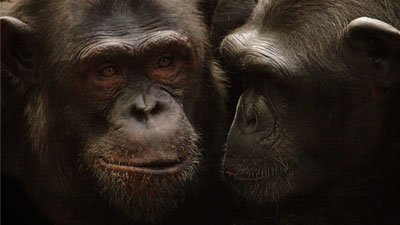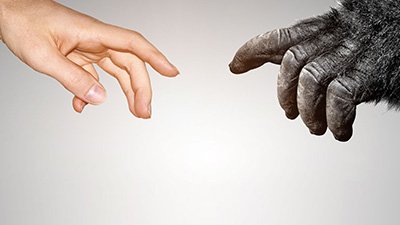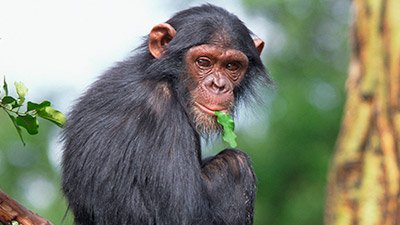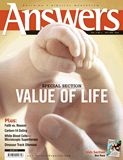What Makes Us Human?
The Nature of Man
God created human beings in His image, with a unique spiritual nature and an eternal destiny. To envisage human beings as nothing more than evolutionarily advanced animals—mere products of random luck over millions of years—is not an inconsequential choice but a dangerous position.
Humans Are Unique
We know from the book of Genesis that God did not use one organism as raw material for the next but instead spoke each into existence over the course of a few days. Human beings have remarkable differences including a spiritual nature that chimps have never and will never have.
Running Makes Us Human?
The popular media is abuzz with the new claim that “running made us human. The essential results of this study are that both living and fossil apes were incapable of endurance running but both living and fossil humans are capable of such running ability.
News About What Makes Us Human?
-
Aug. 5, 2024 from Ken Ham Blog
Evolutionists can’t find what separates humans from animals, because the answer’s in Genesis.
-
March 14, 2019 from Ken Ham Blog
How did humans start cooperating with one another? A recent study suggests the belief in “punitive gods” caused our evolutionary ancestors to begin cooperating.
Articles About What Makes Us Human?
-
May 30, 2021 from Answers Magazine
“Why?” A young child’s barrage of questions isn’t a sign of stubbornness. It reflects an inquisitive mind that’s putting together a verbal map of the universe.
-
Jan. 17, 2017 from Answers in Depth
Though monkeys can’t imitate human language despite speech-ready vocal tracts because of their brains’ wiring, their versatile alarm calls meet their needs.
-
In-Depth ArticleWhat Does It Mean to Be Human?Jan. 1, 2016 from Answers in Depth
Is being human just a matter of accumulating qualities that humans have, even if evolutionists could find a way that ape-like creatures could have done so?
-
Dec. 18, 2015 from Answers in Depth
Evolutionists claim human intelligence, culture, and society evolved because an ape-like ancestor’s brain evolved the need to be shaped by the environment.
-
In-Depth ArticleDo Babbling Bonobos Decipher the Evolutionary Secrets of Baby Talk?Aug. 29, 2015 from Answers in Depth
If additional tests reveal bonobos actually are communicating with one another, the authors’ evolutionary leaps will still be groundless.
-
Jan. 31, 2015 from Answers in Depth
Does a "talking" orangutan fill the gap between monkeys and humans in the evolution and origin of human language?
-
In-Depth ArticleDid Huh? Arise in Every Language through Convergent Evolution?March 13, 2014 from Answers in Depth
Previously thought of as something akin to a grunt, huh? qualifies as a bona fide word, linguists now say.
-
Research PaperDo Chimp Alarm Calls Reveal How Human Language Evolved?Nov. 7, 2013 from News to Know
Does the chimpanzee ability to see-a-snake and sound-a-signal recapitulate the evolutionary underpinnings of human language?
-
Research PaperShow and Tell: What Can Chimps Tell Us?June 17, 2013 from News to Know
Are there “striking similarities” in ape and human communication, and what do they mean?
-
MIT Linguist Claims Human Speech Evolved from BirdsMarch 16, 2013 from News to Know
What do honeybee waggles and birdsong have to do with human speech? An MIT linguist believes they demonstrate that human speech evolved as Darwin thought.
-
Homo Erectus Had Skillfully Designed ToolsFeb. 23, 2013 from News to Know
Homo erectus had style and design of their tools down to a science.
-
Uniqueness of HumansNov. 10, 2012 from News to Know
Uniqueness of humans is reflected in the way their genes are regulated.
-
In-Depth ArticleHow Did We Get So Smart?Aug. 11, 2012 from Answers in Depth
Noticing the intellectual reputation of Neanderthals, it’s worth recalling how a person’s worldview colors his interpretation of data about human origins.
-
Book Chapter2.8 The Essential Nature of Man (OB8)July 26, 2012 from Did God Use Evolution?
It is impossible to understand human nature apart from biblical revelation.
-
Australian Aboriginal Art Discovered in Rock ShelterJune 30, 2012 from News to Know
Aged Australian Aboriginal art discovered at Narwala Gabarnmang rock shelter
-
Handprints in Northern SpainJune 23, 2012 from News to Know
Who left their handprints in northern Spain?
-
Teeth Track Early Agricultural SocietyJune 2, 2012 from News to Know
Teeth track patrimony (property inherited through the male line) and prosperity in early agricultural society.
-
Reading BaboonsApril 21, 2012 from News to Know
Bookish baboons said to demonstrate reading readiness pre-dated evolutionary emergence of humans.
-
South Africa’s Abstract ThoughtMarch 3, 2012 from News to Know
South Africa’s “earliest known evidence of abstract thought”
-
Early Human Beds Discovered In South AfricaDec. 24, 2011 from News to Know
Sleep tight and don’t let the bedbugs bite.
-
Arabian Artifacts Alter Evolutionary MapDec. 10, 2011 from News to Know
Nubian wares scramble human evolutionary map again.
-
High-Tech ToolsJune 25, 2011 from News to Know
The human brain evolved because early humans developed technology?
-
Were Humans a Million Years Ago Britons?July 10, 2010 from News to Know
What were humans like a million years ago—fur-wearing, meat-eating, tool-making Britons?
-
Shell Bits Display Intelligence of Ancient HumansMarch 6, 2010 from News to Know
Bits of shell discovered in South Africa display the intelligence of “ancient” humans.
-
Evolutionary Anthropologists Finding AnswersJan. 23, 2010
Two perennial questions for evolutionary anthropologists are how humans began walking upright and how humans began to make and use stone tools. For one team of scientists, the answers are intertwined.
-
Chimpanzees and FireJan. 2, 2010 from News to Know
When it comes to fires, chimpanzees keep their cool. Does this “reveal a primitive hominid trait”?
-
Monkey Hear, Monkey KnowJuly 11, 2009 from News to Know
If you ain’t no good speaker of English, maybe you should talk to one o’ them thar monkeys to straight’n ya out.
-
Whistling Orangutan Clue to Language EvolutionJan. 3, 2009 from News to Know
Is that the sound of a wolf whistle or an orangutan whistle we hear?
-
Modern Human Sophistication: How Long Did It Take?Dec. 6, 2008
Yesterday’s humans weren’t as sophisticated as today’s humans—according to today’s humans.
-
Social Tests Flounder ApesSept. 8, 2007
A Congolese study headed by doctoral student Esther Herrmann and her advisor, Michael Tomasello, both of the Max Planck Institute for Evolutionary Anthropology in Leipzig, Germany, is the latest research to highlight humans’ intellectual distinction from apes.
-
July 1, 2007 from Answers Magazine
Wooden tools used by African chimpanzees have some evolutionists excited. Researchers have observed chimps in Senegal making spears out of tree branches and then using them.
-
Monkey See, Monkey Talk: Ape CommunicationJune 2, 2007
Researchers are astounded by ape communication skills.
-
Simian Sign LanguageMay 5, 2007
Simian use of gestures is the latest evidence of evolution—at least, that’s the impression given by a BBC NEWS article describing research into how bonobos and chimpanzees communicate.
-
Evolutionists Claim that Running Made us HumanNov. 22, 2004
Yet once again the popular media is alive with the sound of evolutionism. This time the story that has them all abuzz is the new claim that “running made us human.”
-
Magazine ArticleHuman Speech Didn't Evolve from Animal GruntsSept. 1, 1995, pp. 6–7
'All assumptions that human speech developed gradually from animal grunts (the so-called woof-woof theories) or that gestures changed incrementally into audible language, cannot be sustained.'
-
Magazine ArticleAxing Evolutionary ideas—Stone Dead!June 1, 1994, pp. 28–30
One of the most popular myths of human evolution is that stone tools testify to the increasing mental and conceptual abilities of humans as they evolved.
-
Magazine ArticleTalking MonkeysOct. 1, 1982, pp. 6–8
An eccentric German, named Von Osten, set out to show that animals were as clever as men. He spent two years educating a horse which became known as Clever Hans.
Recommended Resources

Answers in Genesis is an apologetics ministry, dedicated to helping Christians defend their faith and proclaim the good news of Jesus Christ.
- Customer Service 800.778.3390
- Available Monday–Friday | 9 AM–5 PM ET
- © 2025 Answers in Genesis











